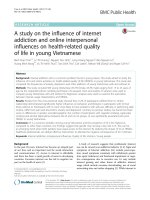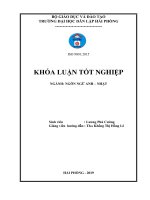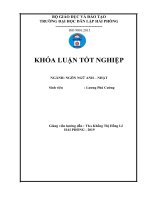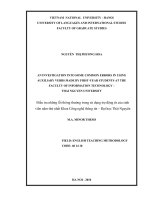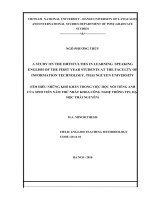Problems encountered by english majors in a consecutive interpreting course a study at the faculty of english linguistics and literature university of social sciences and humanities, ho chi minh city
Bạn đang xem bản rút gọn của tài liệu. Xem và tải ngay bản đầy đủ của tài liệu tại đây (833.44 KB, 117 trang )
MINISTRY OF EDUCATION AND TRAINING
HO CHI MINH CITY UNIVERSITY OF TECHNOLOGY
---------------------------
NGUYEN TRONG QUANG
PROBLEMS ENCOUNTERED BY ENGLISH
MAJORS IN A CONSECUTIVE INTERPRETING
COURSE: A STUDY AT THE FACULTY OF
ENGLISH LINGUISTICS AND LITERATURE UNIVERSITY OF SOCIAL SCIENCES AND
HUMANITIES, HO CHI MINH CITY
Major : English Language
Course code: 60220201
HO CHI MINH CITY, JUNE 2020
MINISTRY OF EDUCATION AND TRAINING
HO CHI MINH CITY UNIVERSITY OF TECHNOLOGY
---------------------------
PROBLEMS ENCOUNTERED BY ENGLISH
MAJORS IN A CONSECUTIVE INTERPRETING
COURSE: A STUDY AT THE FACULTY OF
ENGLISH LINGUISTICS AND LITERATURE UNIVERSITY OF SOCIAL SCIENCES AND
HUMANITIES, HO CHI MINH CITY
Submitted to the
Faculty of English Language
in partial fulfillment of the Master’s degree in English Language
Course code: 60220201
By
NGUYEN TRONG QUANG
Supervised by
NGUYEN THI KIEU THU, Ph.D.
HO CHI MINH CITY, JUNE 2020
The thesis entitled ‘Problems Encountered by English Majors in a Consecutive
Interpreting Course: A Study at the Faculty of English Linguistics and Humanities University of Social Sciences and Humanities, Ho Chi Minh City’ was successfully
defended and approved on 19th June 2020 at Ho Chi Minh City University of
Technology (HUTECH).
Academic supervisor : Ms. Nguyen Thi Kieu Thu, Ph.D.
1.
Examination Committee
Mr. Nguyen Tien Hung, Ph.D
Chair
2.
Ms Nguyen Thi Nhu Ngọc
Reader 1
3.
Mr. Nguyen Dang Nguyen
Reader 2
4.
Ms. Duong My Tham
Member
5.
Mr. Le Van Tuyen
Member, Secretary
On behalf of the Examination Committee
Chair
Nguyen Tien Hung, Ph.D.
HCMC UNIVERSITY OF TECHNOLOGY
POSTGRADUATE INSTITUTE
HCMC,
May 2020.
MASTER’S THESIS REPORT
Student name: Nguyen Trong Quang
Sex : Male
Date of birth: the 1st January 1971
Place of birth : Ho Chi Minh city
Major: English Language
Student code: 1741900081
I- Thesis title:
Problems Encountered by English Majors in a Consecutive Interpreting Course:
A Study at the Faculty of English Linguistics and Literature - University of Social
Sciences and Humanities, Ho Chi Minh City
II- Objectives and contents:
1. Objective
This research focuses on investigating problems that are encountered by English
majors in a consecutive interpreting course at the Faculty of English Linguistics &
Literature - University of Social Sciences and Humanities, Ho Chi Minh City.
2. Content
The study combines the mixed approaches in data collection and analysis including
the questionnaire to survey 157 students of the Faculty of English Linguistics and
Literature in the academic year of 2019 and class observations of students’ interpreting
practice. Data obtained from the survey was analyzed by SPSS and shown in tables.
Additionally the data collected from the observations is also conducted by means of
content analysis and error analysis to further explore and probe common problems of
students when they do interpreting as well as the relationship between their perceptions
about interpreting problems and their interpreting performance.
III- Starting date
: 20/03/2019
IV- Completing date
: 02/05/2020
V- Academic supervisor
: Nguyen Thi Kieu Thu, Ph.D.
ACADEMIC SUPERVISOR
(full name, signature)
Dr. Nguyen Thi Kieu Thu
FACULTY DEAN
(full name, signature)
Dr. Nguyen Thi Kieu Thu
CERTIFICATE OF ORIGINALITY
I certify my authorship of the Master’s Thesis submitted today entitled:
PROBLEMS ENCOUNTERED BY ENGLISH MAJORS IN A
CONSECUTIVE INTERPRETING COURSE: A STUDY AT THE FACULTY
OF ENGLISH LINGUISTICS AND LITERATURE - UNIVERSITY OF
SOCIAL SCIENCES & HUMANITIES, HO CHI MINH CITY
In terms of the statement of requirements for Theses in Master’s programs issued by
the Higher Degree Committee of Faculty of English Language, Ho Chi Minh City
University of Technology.
Ho Chi Minh City, June 2020
NGUYEN TRONG QUANG
i
RETENTION AND USE OF THE THESIS
I hereby state that I, NGUYEN TRONG QUANG, being a candidate for the degree
of Master of Arts (English Language) accept the requirements of the University
relating to the retention and use of Master’s Theses deposited in the Library.
In terms of these conditions, I agree that the original of my Master’s Thesis deposited
in the Library should be accessible for purposes of study and research, in accordance
with the normal conditions established by the Librarian for the care, loan, and
reproduction for theses.
Ho Chi Minh City, June 2020.
NGUYEN TRONG QUANG
ii
ACKNOWLEDGEMENTS
First of all, may I express my heartfelt gratitude to Dr. Nguyen Thi Kieu Thu,
who has offered me myriads of insightful recommendations and helpful instructions
on my research. Indeed, I could not complete the thesis without her timely
encouragement and valuable advice. Her wise guidelines and recommended
references have significantly assisted me in discovering fruitful ideas as well as
oriented me in conducting the thesis.
I am sincerely grateful to the teachers in charge of interpreting classes of the
Faculty of Linguistics and Literature in the University of Social Sciences and
Humanities (USSH) for their generous assistance in allowing me to administer the
questionnaire in their classes and also helping me deliver and collect the
questionnaires. Especially, I would like to express my gratefulness to Dr. Nguyen
Dang Nguyen, who has kindly supported me in assessment and recommendation of
error analysis in respect of students’ interpreting performance in this study.
Furthermore, I would also like to show my honest thanks to the leaders of the Faculty
of the English Language of HUTECH, the Faculty of English Linguistic and
Literature of USSH, who created the opportunity and supported my thesis work.
I also extend my thanks to all of the students from the classes of Interpreting
in the academic year 2019 for their kind cooperation and contribution to my research.
Last of all, I highly appreciate the warm-hearted encouragement and non-stop
inspiration offered by my beloved family members who have been always with me
when I was conducting this thesis.
iii
ABSTRACT
This research focuses on investigating the problems confronted by English
majors of the Faculty of English Linguistics and Literature (FE) at the University of
Social Sciences and Humanities, Ho Chi Minh city (USSH-HCM) when they practice
consecutive interpreting in class. To clarify the learners’ difficulties, the study
attempts to answer two research questions: (1) How do the English majors perceive
problems they encounter in interpreting practice? (2) What are common problems
these students encounter when doing consecutive interpreting in class? The study
used the mixed approaches in data collection and analysis including the questionnaire
to survey 157 students of the EF, USSH-HCM in 2019 and class observations of
students’ interpreting practice, from which data collected was conducted by means of
error analysis to further explore common errors of students when they practise
interpreting and the relationship between their perceptions of interpreting problems
and their real interpreting performance. The results of the study revealed students
confronted several problems when doing interpreting. These problems are: 1)
problems in interpreting skills namely listening, memorizing, note-taking and reexpressing 2) content problems including completeness and accuracy of the meaning,
3) linguistic problems in terms of vocabulary, grammar and pronunciation, 4) other
problems in cultural and psychological domains. The findings also disclosed that
listening and memorizing, the content-related problem, the linguistic problem in
lexical aspect and the cultural problem are the top challenges to the students when
they do interpreting. Furthermore, content-related errors happen the most frequently,
particularly omissions. Lexical errors come to the second rank in terms of frequent
occurrence. The outcomes of the study provide helpful backgrounds to students and
instructors to have suitable changes and updated solutions to their learning and
teaching of interpreting. (281 words)
Keywords: problems, errors, consecutive interpreting, English majors, perception,
interpreting practice.
iv
TABLE OF CONTENTS
Page
Certificate of originality .............................................................................................. i
Retention and use of the thesis. ...................................................................................ii
Acknowledgements ................................................................................................... iii
Abstract ...................................................................................................................... iv
Table of contents ......................................................................................................... v
List of abbreviations .................................................................................................... x
List of tables ............................................................................................................... xi
List of figures ......................................................................................................... xiii
CHAPTER 1: INTRODUCTION
1.1 Background to the study........................................................................................ 1
1.2 Statement of the problem ..................................................................................... 4
1.3 Aims and objectives of the study ......................................................................... 4
1.4 Research questions ............................................................................................... 5
1.5 Scope of the study ................................................................................................ 5
1.6 Significance of the study ...................................................................................... 5
1.7 Definitions of key terms ....................................................................................... 6
1.8 Organization of the study ..................................................................................... 7
CHAPTER 2: LITERATURE REVIEW
2.1
Introduction ...................................................................................................... 8
2.2
The translation theory and pedagogical translation theory .............................. 9
v
2.2.1 The development of translation theory and pedagogical translation theory ... 9
2.3 Translation versus Interpreting ......................................................................... 13
2.3.1 Definition of Translation and Interpreting ................................................... 13
2.3.2 The difference between Translating and Interpreting .................................. 14
2.3.3 Forms of Interpreting ................................................................................... 16
2.4 Consecutive Interpreting .................................................................................... 17
2.4.1 Definition ..................................................................................................... 17
2.4.2 Models of consecutive Interpreting .............................................................. 18
2.4.2.1 Introduction …… ……………………………………………..……… 18
2.4.2.2 Daniel Gile’s Effort Models on Interpreting and Interpreter training .... 18
2.4.3 Stages of Consecutive Interpreting ............................................................. 20
2.4.4 The directionality in consecutive interpreting ............................................ 21
2.5. Teaching & learning of translation & interpreting in universities in Vietnam .. 22
2.6 The problems encountered by students in interpreting ..................................... 24
2.6.1 Introduction ................................................................................................. 24
2.6.2 Problems of interpreting skills .................................................................... 25
2.6.3 Linguistic problems .................................................................................... 27
2.6.4 Content problems ........................................................................................ 27
2.6.5. Other problems ............................................................................................ 28
2.6.5.1 Cultural problem .................................................................................... 28
2.6.5.2 Psychological problem ......................................................................... 29
2.7 Error analysis ................................................................................................... 30
2.7.1. Introduction ................................................................................................. 30
vi
2.7.2. Definition of errors ....................................................................................... 30
2.7.3 Error Analysis in translation and interpreting ............................................. 31
2.7.4 The model of Error Analysis used in the research ...................................... 33
2.8 Previous studies ................................................................................................. 42
2.9 Conceptual framework ...................................................................................... 43
2.10 Summary ......................................................................................................... 46
CHAPTER 3: METHODOLOGY
3.1 Introduction ........................................................................................................ 47
3.2 Research design .................................................................................................. 47
3.3 Research site ....................................................................................................... 47
3.4 Sample and sampling procedures ....................................................................... 48
3.5 Research instruments ........................................................................................ 49
3.5.1 The questionnaire for the students ............................................................... 49
3.5.2 Observations ................................................................................................. 51
3.6 Data collection procedures ................................................................................. 52
3.7 Data analysis procedures .................................................................................... 54
3.7.1 Introduction .................................................................................................. 54
3.7.2 Data analysis in the questionnaire ................................................................ 54
3.7.3 Data analysis in the observation ................................................................... 54
3.8. Validity and Reliability ..................................................................................... 58
3.9. Summary ........................................................................................................... 59
CHAPTER 4: RESULTS AND DISCUSSIONS
4.1 Introduction ...................................................................................................... 60
4.2 Results of the Research .................................................................................... 60
4.2.1 Results of the research question 1 ................................................................ 60
vii
4.2.1.1 Problems of interpreting skills .............................................................. 61
4.2.1.2 The content-related problem ................................................................ 62
4.2.1.3 Linguistic problem ............................................................................... 63
4.2.1.4 Other problems ...................................................................................... 64
4.2.1.5 Summary of students’ problems in consecutive interpreting practice .. 65
4.2.2. Results of the research question 2 ............................................................... 66
4.2.2.1. Data from the observations ................................................................... 66
4.2.2.2. Students’ errors in E-V consecutive interpreting .................................. 73
4.2.2.3. Students’ errors in V-E consecutive interpreting. ................................ 75
4.3. Discussions ........................................................................................................ 78
4.3.1. The interpreting problems perceived by students ....................................... 78
4.3.1.1. The problem of interpreting skills .......................................................... 78
4.3.1.2. The content-related problem ................................................................. 79
4.3.1.3 Relationship between interpreting-skill problem & content problem ..... 79
4.3.1.4. Linguistic problem ................................................................................. 80
4.3.1.5. Other problems ....................................................................................... 80
4.3.2 Common errors in students’ consecutive interpreting ................................. 82
CHAPTER 5: CONCLUSION
5.1 Summary of the main findings of the thesis ...................................................... 84
5.2 Implications of the research ............................................................................... 85
5.2.1 Implications for students ............................................................................. 85
5.2.2 Implications for interpreting instructors and educators ............................... 86
viii
5.3. Limitation of the research ................................................................................. 86
5.4. Recommendations for further research ............................................................. 87
REFERENCES ....................................................................................................... 88
APPENDICES ....................................................................................................... 99
Appendix A: Questionnaire & Cronbach Alpha score ........................................... 99
Appendix B: Error checklists, transcripts & list of students’ interpreting errors ..101
Appendix C: Course Syllabus of Interpreting 1 ................................................... 123
Viber Plagiarism Report ...................................................................................... 124
ix
LIST OF ABBREVIATIONS
AIIC
Association Internationale des Interprètes de Conférence
ATA
American Translators Association
CI
Consecutive Interpreting
ELT
English Language Teaching
E –V
English to Vietnamese
EF
Faculty of English Linguistics and Literature
HUTECH
Ho Chi Minh City University of Technology
HCMC
Ho chi Minh city
L1
native language/first language/ A language
L2
foreign language/second language/B language
NAATI
National Accreditation Authority for Translators & Interpreters
ST
Source Text/Source Language
TESOL
Teaching English of Speakers of Other Languages
TT
Target Text/Target Language
USSH
University of Social Sciences and Humanities
V-E
Vietnamese to English
VNU
Vietnam National University
x
LIST OF TABLES
Table 2.1. Differences between Interpreting and Translation ................................ 16
Table 2.2: Criteria used by Falbo in the Error Analysis ......................................... 34
Table 2.3: Assessment criteria used in E-V consecutive interpreting in the study ... 36
Table 2.4: Assessment criteria used in V-E consecutive interpreting in the study ... 37
Table 3.1: Questionnaire Structure ........................................................................... 50
Table 3.2:
Error identification template for V-E consecutive interpreting ........... 56
Table 3.3 Data analysis methods in dealing with research questions & instrument 58
Table 4.1: Students’ perception on the problems in interpreting skills .................. 61
Table 4.2 Students’ perception on content problem in E-V & V-E interpreting .... 62
Table 4.3: Students’ perception on linguistic problem in E-V & V-E interpreting . 63
Table 4.4: Students’ perception on other problems in E-V & V-E interpreting ..... 64
Table 4.5: Students’ problems in practice of consecutive interpreting .................... 65
Table 4.6: Instances of lexical errors in E-V interpreting ...................................... 67
Table 4.7: Instances of lexical errors in V-E interpreting ...................................... 67
Table 4.8: Instances of grammatical errors in E-V interpreting .............................. 68
Table 4.9: Instances of grammatical errors in V-E interpreting ............................ 69
Table 4.10: Instances of pronunciation errors in V-E interpreting ........................ 70
xi
Table 4.11: Instances of additions, omissions and distortions in E-V interpreting . 71
Table 4.12: Instances of additions, omissions and distortions in V-E interpreting . 72
Table 4.13: Common errors in E-V consecutive interpreting ................................ 73
Table 4.14: Subtypes of errors in E-V consecutive interpreting ............................. 74
Table 4.15: Common errors in V-E consecutive interpreting ................................ 76
Table 4.16 : The subtypes of errors in V-E interpreting ......................................... 77
xii
LIST OF FIGURES
Figure 2.1. Holmes' Map of Translation Studies ..................................................... 10
Figure 2.2. Conceptual framework of the study........................................................ 45
xiii
xiv
CHAPTER 1
INTRODUCTION
1.1
Background to the study
The globalization in the early 21st century has resulted in the boom of
international trade and significant increase of economic integration and cultural
exchanges between countries and therefore has created great demands for translators
and interpreters who play an important role as a disseminator of culture as well as a
mediator of languages. In order to meet these demands, academic institutions in
Vietnam have built up many curricula of translation and interpreting to train this human
resource. As a result, many universities and colleges in Vietnam have introduced
interpreting which is also called interpretation as the obligatory or optional course in
their training programs of applied linguistics. As English is currently the most common
foreign language in Vietnam, the majority of these schools concentrate on the training
of interpreting between Vietnamese as the first language or mother tongue (L1) and
English as the second language (L2).
However, one difficulty has arisen and badly influenced on the interpreter
training in many Vietnamese academic institutions. Kim Van Tat (2006) points out
“poor” facilities and equipment as one of the main barriers to the teaching and learning
of English in subsidiary units in Hanoi National University. Vietnam Vocational
Training Report 2011 issued by the National Institute for Vocational Training also
emphasizes the “insufficient” facilities and equipment of vocational training institutes.
Moreover, the Data Collection Survey (2014) by Japan International Cooperation
Center reveals “the shortages of
laboratory facilities and funding for supplies”.
According to the survey, these shortages limit the practicality of the training curriculum
and makes the teaching “too theoretical”. In the “Scheme on Foreign Language
Teaching and Learning in the National Education System in 2008-2020”, the Ministry
of Education also mentions this real situation in which “teaching and learning facilities
at universities and academic institutes in Vietnam are very limited” and specifically one
lab room is serviced to 2000 students on average (2008, p. 16). Consequently, unlike
the training of interpreting in many countries in the world where both simultaneous and
1
consecutive interpreting is brought into the curriculum, consecutive interpreting is
currently the major in the training course of Vietnamese universities rather than
simultaneous interpreting that requires both good facilities such as language labs,
supporting devices for interpreting practice and qualified teaching staffs who should not
only master language skills and teaching methodology but also have sufficient
experience in professional translation and interpreting while most of academic
institutions are ill-equipped for such above-mentioned demands as well as short of the
suitable personnel to be capable of interpreting instruction because the majority of
teachers come from the field of TESOL. Moreover, according to Lam Quang Dong
(2017), current translation and interpreting instructors rarely have favorable conditions
in practically doing interpretation and translation because they busily cope with a big
volume of teaching, research and other administrative tasks in their school or
workplaces. In fact, few of them have professional chance of getting involved in
consecutive interpreting, let alone simultaneous interpreting that needs much real-life
exposure and essential professional skills in practice. In the survey of current situation
of English-majored students in eight universities in Ho Chi Minh city, Le Thi Thanh
Thu et al. (2012) detect the fact that most of the universities have few teaching staffs
who specialize in interpreting to assist their students to practice interpreting tasks
professionally. Pham Vu Phi Ho (2015) also shares the same viewpoint that it is really
“a challenge” for teachers to instruct students to do interpreting.
At the Faculty of English Linguistics and Literature (EF) of the University of
Social Sciences and Humanities (USSH), written translation is taught to students from
their second year of study until the following years in the university whereas
interpreting is only instructed nearly at the end of the fourth year, which is also the final
year of students’ study in their curriculum. Though students’ specialization is both
translation and interpreting, the amount of training time in interpreting tends to be lower
than the time frame of written translation subjects. As a consequence, students seem to
view interpreting as a “difficult subject” and often study it with much discomfort and
difficulty. Though interpreting is considered as a practical or applied study domain, few
students can select it as the occupational choice after graduation because their
2
acquisition of translation and interpreting competence from these training courses is
limited and insufficient.
In comparison to written translation, interpreting is a new field in terms of theory
and practice. Actually, interpreting is not only a challenge to students but also to
teachers especially in practice because it is a real-time exercise of spoken translation in
many situations like conversations, meetings, presentations, seminars and conferences,
etc. whereas written translation tasks focus on dealing with recorded documents such
as business letters, newspaper articles, books and other written documents which are
“frozen in time”. Due to this significant difference, interpreting seems to be more
demanding and difficult in views of interaction and task pressure. Especially in
simultaneous interpreting, it becomes harder owing to the ‘real-time combination” of
several tasks including language comprehension, language production and so forth
(Seeber, 2015). Moreover, the amount of training time period for written translation in
university curricula is often greater than the duration of interpreting study and practice.
Up to now there have been a lot of studies on interpreting as a part or a branch
of Translation Studies but little research in pedagogical perspective. Interpreting is
always considered as one of the most challenging tasks in translating. Tran Thi Le Dung
(2016, p. 47) believes that interpretation is a difficult task which requires good
combination of complicated skills in terms of listening and information processing. The
person who conducts interpreting is required to possess good listening skills, excellent
capacity of short-term memory, quick information processing, good linguistic
competence and adequate cultural awareness. Tran Thi Huyen (2017) regards
interpreting as one of the most difficult practicing skills for English majors in her
university. Other researchers as Gile (1995) and Moser-Mercer (1997) come to an
agreement that interpreting is difficult and complicated. Several studies have been
concentrated on the pedagogical approach in interpreting such as curriculum design,
teaching methods and approaches, interactions in interpreting class and so forth.
Currently, researchers are more interested in the combination of both linguistic and
cognitive approaches in the interpreting pedagogy and this research paper will rely on
these theoretical domains to survey and investigate challenges and problems that
3
English majored students have been coping with during their attendance in classes of
consecutive interpreting.
1.2 Statement of the problem
In the Faculty of English Linguistics and Literature (EF) of the University of
Social Sciences and Humanities in Ho Chi Minh city (USSH-HCM), interpreting has
been introduced into the training programs of this institution since 2009 (Proceedings
of Translation and Interpreting Conference in USSH-VNU-HCMC in 2016, p. 372) and
as compared to other study subjects such as written translation, semantics, phonology,
etc., it is a “young” one to the EF of USSH-HCM. Consequently, in comparison with
the research in teaching of translation which has been much devoted in the FE, studies
generally in the field of interpreting and particularly in interpreter training seem to be
rare and lack of concentration and comprehensiveness in USSH. Up to now lots of
researchers in USSH have conducted studies on students’ difficulties and problems in
language skills and written translation. However, there have not been many studies
dedicated to the fields of learning and training of interpreting. This is the reason why
the researcher decided to investigate students’ feelings and thinking about the problems
they confront in their interpreting practice as well as explore their common problems
during this process, thereby grasp deeper understanding of their obstacles and
difficulties so as to help the students tackle and/or reduce such problems.
1.3 Aims and objectives of the study
The study aims at investigating the problems that are encountered by English
majors in a consecutive interpreting course at the Faculty of English Linguistics &
Literature - University of Social Sciences and Humanities, Ho Chi Minh City (EFUSSH). To achieve these aims, the objectives are indicated as follows:
(1) To survey what English majors of EF-USSH think about problems they encounter
during their practice of consecutive interpreting in class;
(2) To explore the common problems that the students encounter as well as to identify
errors they have made during their practice of consecutive interpreting from English to
Vietnamese and vice versa.
4
1.4 Research questions
The purpose of the study is to focus on answering the following research questions:
(1) How do the English majors at the EF, USSH-HCM perceive problems they
encounter in interpreting practice?
(2) What are the common problems that English majors at EF, USSH-HCM
encounter when practicing consecutive interpreting in class?
1.5
Scope of the study
The study focuses on English majors of the BA (Bachelor of Arts) program at the
Faculty of English Linguistics & Literature, the University of Social Sciences and
Humanities, Vietnam National University HCMC. However, due to the nature of the
topic, only fourth-year or senior students are chosen as the subjects of the study, which
focuses on investigating the problems encountered by these students in their
consecutive interpreting course, excluding other (written) translation courses, such as
Translation Theory, Basic Translation, Advanced Translation and so on. The scope of
the study is limited in identifying the problems that they have during the course, other
factors such as the effectiveness of the teaching methods, the suitability of the teaching
materials or the attitude of the students towards the course are not discussed.
1.6 Significance of the study.
Theoretically, this research follows the combination of a variety of approaches in
linguistic, psycho-linguistic, cognitive and cultural aspects to investigate interpreting
problems encountered by undergraduate students. The outcomes of the study based on
empirical analysis enable us to explore the student’s perceptions more deeply and
precisely. Currently such inter-discipline studies are still few and this research may
partially contribute to the field of translation studies and interpreting pedagogy and also
shed light on the flexible application of various methods rather than only linguistic tool
to deal with key issues in the theory and practice of translator and interpreter training,
which remains a big gap for translation theorists.
5
Practically, along with the instructor, students are the main players in the class
of translation and interpreting. Therefore, it is really helpful for both teachers and
translation scholars to investigate their views and beliefs. Their opinions and viewpoints
drawn from the study in regard to the challenges and obstacles during their interpreting
practice and study will enable useful findings which may assist the teacher and the
researcher to have appropriate adjustments and modifications in the curriculum, the
teaching method or discover solutions to help the learner to gain better and more fruitful
competence of interpreting. Additionally, the study is a contribution to the teaching and
learning of interpreting, and a good source of reference for those who are interested in
the area.
1.7
Definitions of key terms
In this research paper, several terms should be clarified and defined to assure the
accurate and consistent understanding of the issues presented. The terminology is
frequently used in this research based on the following key definitions:
Problems: difficulties or trouble encountered by students.
Perceptions: thinking or insights of students about problems they confront.
Interpreting versus Interpretation: The term “Interpretation” is also used by some
scholars and translators to refer to “interpreting” though the use frequency of this
term is lower. In this study, the term Interpreting is chosen as it is officially
adopted by the administrators at the research site.
Consecutive interpreting (CI): a mode of interpreting in which the interpreter
gives his/her spoken translation after the speaker completes a few sentences. The
interpreter listens and takes notes (if any) as the speaker is presenting the
message in the source text, and when the speaker pauses, the interpreter orally
translate the message into the target language.
An error in this study is considered as a fault or mistake in interpreting
performance in linguistic, cultural, content-based and interpreting-skilled
aspects.
English majors: in the current study, it refers to fourth-year or senior students
specializing in English study, translation and interpreting branch at EF, USSH.
6


